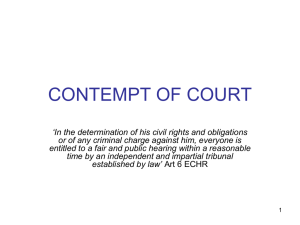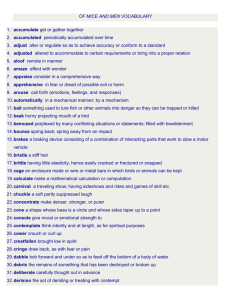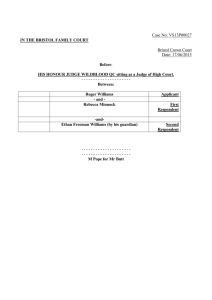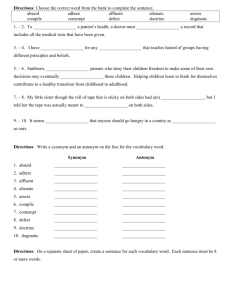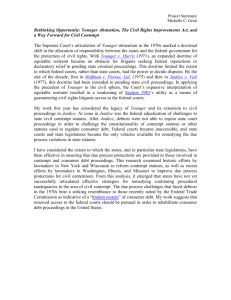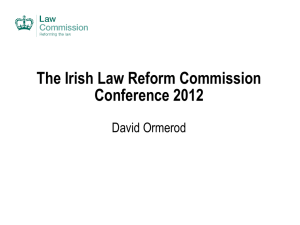Contempt of Court in Family Law: Washington Basics
advertisement
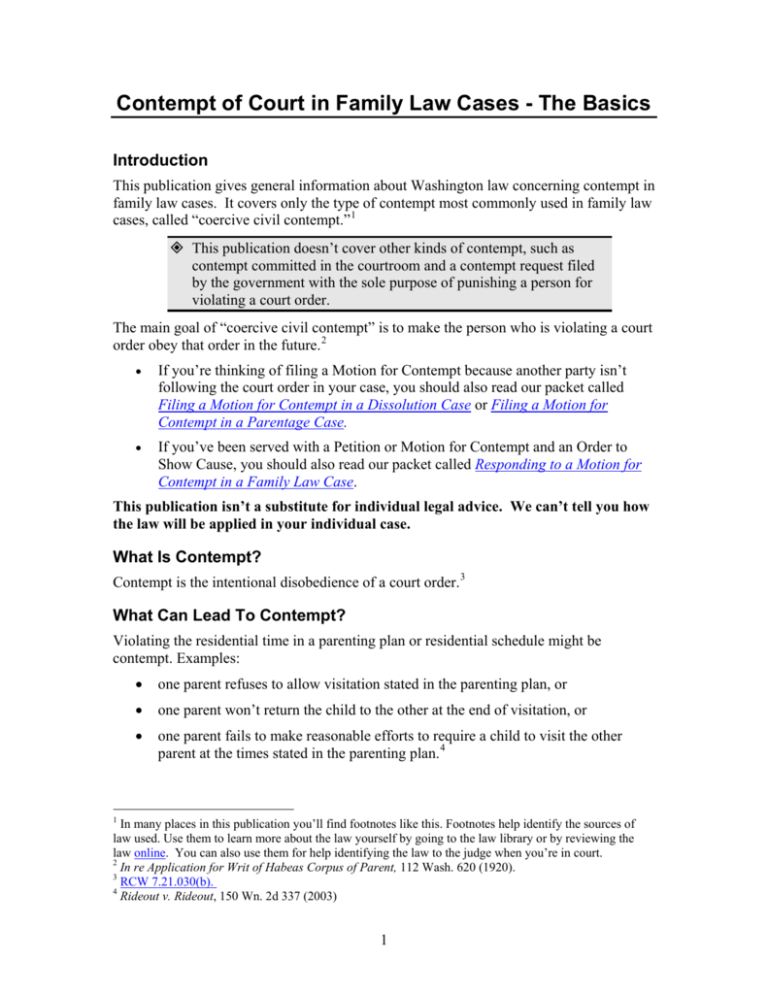
Contempt of Court in Family Law Cases - The Basics Introduction This publication gives general information about Washington law concerning contempt in family law cases. It covers only the type of contempt most commonly used in family law cases, called “coercive civil contempt.” 1 This publication doesn’t cover other kinds of contempt, such as contempt committed in the courtroom and a contempt request filed by the government with the sole purpose of punishing a person for violating a court order. The main goal of “coercive civil contempt” is to make the person who is violating a court order obey that order in the future. 2 If you’re thinking of filing a Motion for Contempt because another party isn’t following the court order in your case, you should also read our packet called Filing a Motion for Contempt in a Dissolution Case or Filing a Motion for Contempt in a Parentage Case. If you’ve been served with a Petition or Motion for Contempt and an Order to Show Cause, you should also read our packet called Responding to a Motion for Contempt in a Family Law Case. This publication isn’t a substitute for individual legal advice. We can’t tell you how the law will be applied in your individual case. What Is Contempt? Contempt is the intentional disobedience of a court order. 3 What Can Lead To Contempt? Violating the residential time in a parenting plan or residential schedule might be contempt. Examples: one parent refuses to allow visitation stated in the parenting plan, or one parent won’t return the child to the other at the end of visitation, or one parent fails to make reasonable efforts to require a child to visit the other parent at the times stated in the parenting plan. 4 1 In many places in this publication you’ll find footnotes like this. Footnotes help identify the sources of law used. Use them to learn more about the law yourself by going to the law library or by reviewing the law online. You can also use them for help identifying the law to the judge when you’re in court. 2 In re Application for Writ of Habeas Corpus of Parent, 112 Wash. 620 (1920). 3 RCW 7.21.030(b). 4 Rideout v. Rideout, 150 Wn. 2d 337 (2003) 1 Contempt can happen by action (such as violating a restraining order) or by failure to act (such as not paying ordered child support or spousal maintenance). You can also use contempt to force the other party to deliver property to you, if a court order required the delivery. 5 You can use contempt during a divorce, parentage, or third party custody action to enforce final orders from a court or an administrative agency. You can also use contempt to enforce temporary orders and restraining orders. NOTE: Contempt isn’t available for all violations. Examples: you can’t use contempt to obtain property settlement payments, unless they’re related to child support or maintenance.6 You can’t use contempt once a court order has ended or been modified. 7 Contempt is a severe remedy. You shouldn’t use it routinely. Contempt is also not always the best or most effective remedy. Sometimes it can just make conflict even worse. Courts hesitate to find a person in contempt unless the violation is serious. What Can The Court Do If It Finds Contempt? The goal in the type of contempt we’re discussing here is to have the party follow the court order in the future. The court can order many different remedies to accomplish this goal. 8 Here are some types of things the court can order, depending upon the violation: order the person in contempt to get counseling; order the person in contempt to complete a parenting class; order the person in contempt to look for work a certain number of hours a week. The court can also order future hearings to check whether the person in contempt is now obeying the order. For violation of a parenting plan, the court can also: order that one parent receive additional make-up residential time with the children; award attorneys fees; order a civil penalty; order greater penalties for the second contempt violation in three years. 9 If the judge believes the person in contempt probably won’t be able to obey the order in the future: 5 State ex rel. Sargent v. Superior Court for King County, 71 Wash. 495 (1913) . In re Marriage of Young, 26 Wn. App. 843, 615 P. 2d 508 (1980). But it can be used to order that property awarded actually be delivered. State ex rel. Sargent v. Superior Court, 71 Wash. 495 (1913) 7 Exception: unpaid child support can, in some circumstances, be collected through contempt even after the child becomes an adult, RCW 26.18.050(5). 8 In re James, 79 Wn. App. 436 (1995) 9 RCW 26.09.160 (2) –(6) 6 2 the court may tell the person to file a motion to modify (change) the court order so that they don’t continue to violate it. The court can also enter a judgment for money due under the order (example: back child support). The court can order jail time, but only as a last resort and only to require someone to obey the court order, not to punish them. 10 A contempt order must specify what action the person can take to purge (cure) the contempt. 11 What Must I Show To Prove that Contempt Has Occurred? Before finding a person in contempt, the court must find: There’s a valid court order in effect, 12 The other person knows about the court order, The facts show a plain violation of the order,13 Notice of the contempt hearing and a chance to be heard have been given, and Contempt is an appropriate remedy for the violation. If the contempt is for a parenting plan violation, there must be evidence that the violation was in bad faith or, there must be evidence that the person violating the plan engaged in intentional misconduct, or the court must find that prior sanctions haven’t led to compliance with the order. 14 Refusal to perform a duty in the parenting plan is assumed to be in bad faith. The law presumes you have the ability to obey the parenting plan. If you don’t obey it, you must show inability or a reasonable excuse. 15 How Do I Decide If Contempt Is Appropriate In My Case? If you’re interested in filing for contempt, consider these questions before you begin filling out the contempt forms: Is the order still in effect? Some orders end at a specific date or when a final order is entered. You can’t use Contempt to enforce an order that’s ended. (Exception: child support orders can be enforced through contempt even after the child becomes an adult.) 10 Jail time as punishment is a different kind of contempt. We don’t cover it in this publication. In re Detention of Rebecca K 101Wn. App. 309 (2000), King v. DSHS, 110 Wash 2nd. 793 (1988) 12 Child support orders can be enforced by contempt even after the child is an adult, unless back due support has been paid in full. RCW 26.18.050(5). 13 In re Marriage of Humphreys, 79 Wn. App. 596 (1995). 14 RCW 26.09.160(2)(b). 15 Rideout v. Rideout, 150 Wn. 2d.337 (2003). 11 3 Does the other person know of the court order? Have you had the person served with a copy of it? If not, was that person present in court when the order was signed? 16 If not, notice may not be sufficient. Without proper notice of an order, the court won’t hear a contempt motion for violating it. (For restraining orders, having a law enforcement officer read a certified copy of the order to a person is considered notice of the order to that person.) 17 Have you met any responsibilities you might have yourself under the order to trigger the other person’s duty in the same area? Example: if you’re allowed visitation only after you’ve completed a drug treatment program, and now you’ve asked for visitation and been refused, have you completed the program ordered and have you shown the other party you completed it? Does the order clearly describe the other person’s responsibilities? If not, then contempt isn’t a realistic remedy until the court order is clarified or modified and until you can prove your case. Do you expect the other person to deny their violation? If so, do you have enough proof of the violation? If you can’t show by your own or your witnesses’ firsthand knowledge that the other party violated the order, then the court won’t be able to find the other person in contempt. Does the other person have a reasonable excuse for the violation? In most contempt cases concerning parenting plans or child support, once you’ve have shown the order is valid and the other person knows of the order but has violated it, the other person must either show a reasonable excuse (for parenting plan violations) or show inability to obey despite reasonable efforts (child support and parenting plan cases). If the other party can do one of these, a contempt motion may just be a waste of time. Is contempt the most suitable remedy? When someone fails to follow a court order, there might be more than one kind of legal action you can take. To know which action is most suitable in your case, you should seek individual legal advice. What Alternatives Do I Have To Contempt? Other possible legal remedies you might use to enforce an order include: Demand letter: Send the other party a letter explaining the violations. Ask him/her to correct them. (Keep a copy of the letter for your own records. Send it by regular and certified mail.) A letter can sometimes lead to an agreed solution. It can also show that you’re being reasonable. It can also help show that the other party knows of the court’s order and that you’re unhappy with his/her behavior. Your letter should be specific, polite, and business-like. 16 17 In re Koome, 82 Wn. 2d 816, 821 (1973) RCW 26.09.300(2) 4 Motion to Clarify: You can use this when a court order is vague or unclear. Example: when the order just says “reasonable visitation” and the parties disagree on what is reasonable. Motion/Petition to Modify: You can use this to ask the court to change a court order instead of asking the court to enforce an order. (If this is your situation, consult our website for a list of packets you might use.) Enforcement and collection: For many kinds of money, support, and property orders, collection actions such as wage assignment, garnishment, or foreclosure are more effective than contempt. In the case of child support (and spousal maintenance if there’s also a child support order), collection services are available for free from the Child Support Division of DSHS. Dispute resolution: Many parenting plans contain an alternative procedure to court for you to try first if you disagree about the parenting plan. It may be required in your individual case. Read your court order to see. Criminal prosecution: Available in very serious cases. NOTE: Even where contempt is potentially available as a remedy, it’s expensive, the court may be reluctant to act, and contempt is hard to prove. What Are The Risks Of Filing For Contempt? Contempt may be too risky in your particular case. Think about these possible problems before you decide to file for contempt. 1. Defending a modification motion. Sometimes filing a Motion for Contempt will lead the other party to file a motion to change the court order. Example: the other party may try to reduce child support or ask for different residential time. If you’re not ready to spend time defending against this type of motion, don’t file for contempt. 2. Defending a contempt motion. Have you obeyed the Court’s orders yourself? If you’re not following the court order yourself, the other party may respond to your motion for contempt by filing his/her own contempt motion against you. Or s/he may argue that your violation of the order prevents him/her from obeying it. 3. “Crying wolf.” Is the violation an important one? Courts don’t like to hold a person in contempt for violation of a small item, even if the violation happens more than once. 4. Emotional cost. Going to court often creates hard feelings. It may also upset your children. It can also increase the risk of destructive conduct by the other party. Are these dangers in your case? If so, do you want to proceed anyway? 5. Risk of fees. In some cases the court can or must charge the losing party with fees. Example: in contempt for parenting plan violations, if the court finds you 5 had no reasonable basis for the motion, it will order you to pay the other party’s attorneys fees. 18 I’ve Been Served with a Contempt Motion. What are My Defenses? Here are some possible defenses to a charge of contempt: 1. The Court order is invalid because the court lacked jurisdiction. “Lacked jurisdiction” means that the court had no authority to act (subject matter jurisdiction), or you weren’t served with legal notice in the original case (personal jurisdiction). 2. You didn’t violate the order. Example: if the motion asks for back due support, proof of payment is a defense. 3. You’re unable to obey the order through no fault of your own. 19 If the charge is not paying child support, and you claim you’re unable to pay, you must show diligence in seeking work, saving assets, or otherwise becoming able to comply. 20 If the charge is a parenting plan violation, the court will presume you have the ability to follow the parenting plan. You must prove lack of ability or reasonable excuse. 21 4. No knowledge of the order. 22 (Use this defense only if you can prove you were never properly served with notice of the hearing that led to the order.) 5. Improper service of the Order to Show Cause scheduling the contempt hearing, or not enough time to respond. (This is only a temporary defense. The other side can get out of contempt before you even get back to court by giving you the proper notice and time to respond.) 6. The order is unclear or seems to have more than one possible meaning. (But you may then at least have some duty to try to obey the order as you interpret it and/or to seek clarification. You can’t just ignore the order.) 7. The Court order has ended. (Examples: a temporary order has expired; or a parenting plan has been modified.) 8. A financial order isn’t related to support. 23 9. Occasionally, agreement not to enforce the order by the other person or delay in enforcing can be a defense. However, because the court has made the order, not the other party, it’s very risky to agree to ignore an order or to rely on the other party saying they won’t enforce it. 18 RCW 26.09.160(7). State v. Olsen, 54 Wn. 2d 272, 340 P. 2d 171 (1959), State v. Mecca Twin Theater, 82 Wn. 2d 87, 507 P. 2d 1165 (1973) 20 RCW 26.18.050 (4). 21 Rideout v. Rideout, 150 Wn. 2d 337 (2003) 22 State ex rel. Ewing v. Morris, 120 Wash. 146 (1922), In re Marriage of Maxfield, 47 Wn App. 69 (1987) 23 In re Marriage of Young 26 Wn. App. 843, 615 P. 2d 508 (1980). 19 6 The following items are probably NOT good defenses: 1. Saying you violated the order because someone advised you to violate it (whether the advice came from a lawyer or just a friend or family member). 2. You disagree with the order. 3. You believe the judge made a mistake by signing the order 24 . 4. The other parent violated their own responsibilities under the order. (Example: if one parent fails to allow visitation, the other isn’t excused from paying child support.) 25 What If the Other Party’s In the Military? If the other party in your case is on active duty in the military, s/he may be able to have the court hearings stayed (stopped) for the duration of his/her active duty. If the case concerns child support or maintenance, however, the Division of Child Support may be able to help collect support/maintenance directly from the military if the obligated party isn’t paying. What’s The Procedure for Contempt? Usually you’ll have to file a motion. A Motion is not a new case. It takes place in an existing case. It’s an effort to enforce an existing order. You’ll file your contempt motion in the same county and court where the original order was entered. (If you have an order from another county or state, you must take additional steps to start a new court case in the new county.) A contempt proceeding includes 26 Filing a motion and declaration with the court, Obtaining a hearing date by having the court sign an Order to Show Cause, 27 Having the contempt papers (and usually the original court order) properly delivered to every other party, Participating in the contempt hearing, Entering an order showing the judge’s decision at the hearing. The Division of Child Support (DCS) uses extra steps if it files for contempt in to enforce a child support order that had been issued by an agency. In their cases, contempt may begin with the filing and service of a Summons and Petition, together with a Motion and the other documents. 24 Dike v. Dike, 75 Wn. 2d 1, 448 P. 2d 490 (1968). Wheeler v. Wheeler, 37 Wn. 2d 159, 222 P. 2d 400 (1950). 26 This information assumes that the original order and the contempt motion are filed in the same county. Court. We don’t discuss the additional steps you need to take if this isn’t the case. 27 See our packet Filing for Contempt for more information about the procedure and for forms and instructions. 25 7 What Happens At The Contempt Hearing? Usually the court hears many different cases on the same day. There will be a court calendar listing all the cases to be heard. In each case, including yours, the court will listen to both parties’ arguments. Some courts require live testimony at the hearing. Some courts may require you to request permission in advance to provide live testimony. And some courts never allow live testimony. Call clerk of the court where you’re filing to find out the local procedure. The person who’s filed for contempt must show: there’s a court order in place AND the other person knows of the order, AND the other person has violated the court order AND the other person’s been given reasonable notice of the contempt hearing and the violations claimed. The person charged with contempt is entitled to present defenses. Usually, if s/he claims that s/he cannot obey the court order, s/he must have evidence to prove this. If s/he has filed his/her own motions, they may be heard at the same time, if you’ve been given proper notice. If jail time is requested as a remedy, the person charged with contempt is entitled to a court-appointed attorney if s/he can’t afford an attorney. 28 If the other party fails to come to the court hearing or to review hearings, the court may issue a bench warrant for his/her arrest. After hearing from both parties, the court makes a decision about the Motion for Contempt and any other motions before the court. The party who wins at the hearing then presents a written order for the court to sign. The judge usually signs that order the same day. Sometimes the judge schedules a new hearing date for the order to be presented for signature. The order must accurately summarize the judge’s decision. What Happens if the Court Enters a Contempt Order? To remedy contempt, the court can order one or more of the following: 1. An order designed to make the person obey the order in the future; 2. A forfeiture not to exceed $2,000 for each day the contempt continues 29 ; 3. Payment for losses to the injured party; 30 4. Costs to the injured party in bringing the contempt motion; 31 28 Tetro v. Tetro, RCW 7.21.030 30 RCW 7.21.030(3). 31 RCW 7.21.030, RCW 26.18.160 29 8 5. If the parent’s been found in contempt for violation of a parenting plan at least twice in the last three years, that may be grounds for modification of the residential provisions of the parenting plan (see RCW 26.09.260(2)(d)); 6. Imprisonment, as a last resort and only so long as it serves the purpose of obtaining compliance with the order.32 3107EN This publication provides general information concerning your rights and duties. It is not intended to replace specific legal advice. This information is correct as of the date of its printing, February 2010. © 2010 Northwest Justice Project — 1-888-201-1014 (Permission for copying and distribution granted to the Alliance for Equal Justice and to individuals for non-commercial purposes only.) 32 King v. Department if Social and Health Services, 110 Wn. 2d 793, 756 P .2d 1303 (1988). 9

